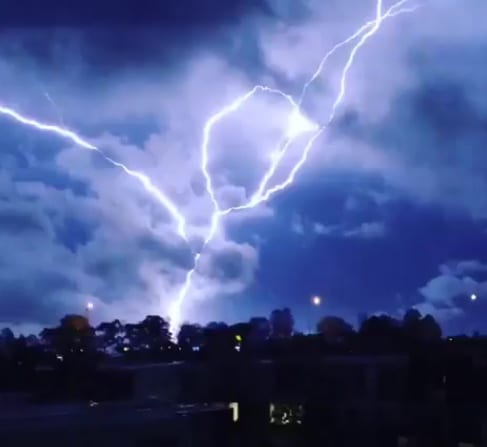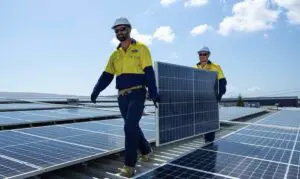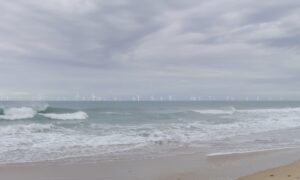Note: This is an un-referenced, lightly-edited extract from Ketan Joshi’s Windfall:Unlocking a Fossil Free Future, out now with NewSouth Publishing. You can buy the book here.
During emergencies, Australians overwhelmingly turn to one place for reliable information – the Australian Broadcasting Corporation (ABC); surveys measuring trust in public institutions place the ABC at the top. On the night of the September 2016 South Australia blackout, many millions of Australians would have tuned into the ABC’s 24-hour news channel for the latest updates. And on that night, the channel’s political editor Chris Uhlmann laid the seeds for how media and politics would react to the event, during a nine minute interview with Senator Nick Xenophon (the South Australian politician who’d led the inquiry into wind turbine syndrome).
‘Forty per cent of South Australia’s power is wind generated, and that has the problem of being intermittent. What we understand at the moment is that those turbines aren’t turning because the wind is blowing too fast’, declared Uhlmann, when he opened the segment. He would repeat that 40 per cent value during the interview, despite the mix being closer to 30 per cent for that month. The claim that the turbines were offline because the ‘wind was blowing too fast’ – completely false – was repeated three times.
‘[The South Australian government] hasn’t taken into account what the consequences are when you put that kind of intermittent energy onto a grid’, Uhlmann insisted, during the interview. ‘It would seem that South Australia has produced this circumstance itself in some ways, on the power mix it is relying on’, Xenophon eagerly concurred. ‘The generators don’t work when the wind is blowing too hard’, he added. ‘This shouldn’t have happened. If heads have to roll, then so be it.’
This interview was the starting point for a broader public narrative where the goal was to blame something inherent to wind power, rather than something resolvable. The argument ran roughly like this: you can’t build a wind turbine that stays online during a thunderstorm. So if the South Australian turbines had shut down due to high winds, the only way to keep the power online would be to never build wind turbines. Uhlmann and Xenophon were clear in their efforts to blame something incurable, rather than something fixable.
The narrative began to spread virally across Australia’s media outlets. ‘Where’s those wind turbines when you need them?’ wrote The Australian’s political columnist, Michael Owen on the night of the blackout. The falsehoods were repeated on the ABC’s 7.30 program, in which a reporter declared, when questioning then energy minister Josh Frydenberg, that ‘South Australia gets 40 per cent of its power from wind power but that is intermittent and on days like today, I understand, the wind power wasn’t operating because of the storm.’
Days later, Uhlmann’s articles published on the ABC website claimed too much wind power was being generated, and that was what caused the blackout: ‘It could also be a problem if wind was supplying the bulk of South Australia’s power … meaning there was little or no synchronous generation inside South Australia. Before the power outage yesterday, the wind was blowing a gale and the turbines were supplying 70 per cent of the state’s power.’
Those early moments were shotgun blasts of contradictory theories that all had one commonality – an attempt to blame South Australia’s blackout on something inherent to wind power. This was designed to serve as an indictment of climate action, and an affirmation of the oft-repeated warnings that decarbonisation would be ruinous.
The story that emerged in the wake of the system black – that South Australia’s blackout was caused by the transition to renewable energy – stuck like dried baby cereal to Australia’s political and media landscape and it has remained there since. So many of the blackouts since then that have occurred either in South Australia or Victoria (undergoing its own slower transition to renewables) have been linked to the presence of wind power. Politicians understand the currency of darkness and loss, and it was mentioned hundreds of times by government players framing the event as the direct consequence of the state government’s support for renewable energy.
‘The member for Port Adelaide [Mark Butler] should be ashamed to associate himself with that failed, big experiment in South Australia, from a tired old Labor government, nearly 16 years old. The Labor Party is the party of higher prices and a less stable power system’, declared then energy minister Josh Frydenberg, in parliament. Fellow former energy minister Melissa Price said ‘Let’s look at the gold star winner, South Australia – a Labor government which gave Australia its first state-wide blackout. What a legacy, what an absolute bunch of champions! There were 1.7 million people with no lights on, and half a billion dollars of taxpayer money was what the Labor government cost South Australians. And we know that a Shorten government would take that failed experiment to a national scale.’
Things got sillier, quickly. When a plug fell out of a rotating stage at an Adele concert, the Today Show said, ‘Adele found herself rolling in the deep of SA’s power debate’, above the strapline ‘SA POWER CRISIS’. An army of fake Twitter accounts blaming the blackout on renewables were linked to a Western Australian mining lobby. The actual mix of reasons behind the event were lost irretrievably in a haze of motivated storytelling. The lie was repeated so many times that it was assumed to be true. South Australia was framed as an electrically famished land, plunged into darkness every second of every day because turbines were sitting idle without wind, generating too much power or generating it too variably. The story became a protective, magical chant, designed to ward off the evil spirits of deliberation and logic.
Any blackout that happened in a state with wind turbines was assumed to have been cause by renewable energy (just as anybody who experienced headaches or nausea near a wind farm could happily assume that the turbines were to blame). This was the big, dramatic, impactful event that critics hoped would turn the public against renewable energy. They wanted Chernobyl, but for wind turbines.
They didn’t get it, of course. Public support for renewables did not waver in light of that campaign. Even when South Australia’s Labor government was ousted and replaced by the Liberal government, policy support for renewables and decarbonisation continued, with a much-needed focus on storage, particularly individual and community-owned storage, coming through.
In fact, many other states have adopted strong emissions targets along with South Australia, and the state has led the way in pioneering brilliant ways to integrate renewable energy. Several big events, notably the black summer bushfires, have stress-tested this upgraded grid in SA, and it has held up admirably. The remaining problem? The federal government; who refuse to plan or lead on this transition. They’re a stick in the spoke, even as so many former critics come on board.
This is an un-referenced, lightly-edited extract from Ketan Joshi’s Windfall:Unlocking a Fossil Free Future, out now with NewSouth Publishing. You can buy the book here.









